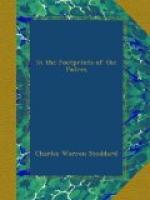“It was evening at the Tehama. The apothecary, whose shop formed the southeastern corner of that edifice, had lighted his lamps, which, shining through those large glass bottles in the window, filled with red and blue liquors—once supposed by this author, when young and innocent, to be medicines of the most potent description,—lit up the faces of the passers-by with an unearthly glare, and exaggerated the general redness and blueness of their noses.”
The third and last chapter concludes with these words: “The Tehama House is still there.” The laughter-making and laughter-loving Phoenix has long since gone to his reward. Of the Oriental Hotel scarcely a tradition remains. The Tehama House—what there is left of it—has been spirited to the north side of Broadway within a stone’s-throw of the city and county jail. The cliffs of Telegraph Hill browbeat it. It is, one might say, the last of its race.
Another hospice—if it was a hospice—I remember. It stood on the corner of Clay and Sansome Streets, and was a very ordinary building, erected over the hulk of a ship that had been stranded there in the days of Forty-nine. I saw the building torn down and the bones of the hulk disinterred years after the water lots that had been filled in for several squares, between it and the old harbor, were covered with substantial buildings. When that bark was buoyant it had weathered Cape Horn with a small army of argonauts. They had gone their way to dusty death; she had buried her nose on the water-front and had been smothered to death in the mire. Docks, streets, grew up around her; a building had snuffed her out of sight and mind. The old building gave place to a new one; the bark was resurrected in order to lay a solid foundation for the new block that was to be. In the hold of this forgotten bark was discovered a forgotten case of champagne. It had been sunk in mud and ooze for years. When the bottles were opened the corks refused to pop, and nobody dared to touch the “bilge” that was within. All this was on the happy hem of Happy Valley—and still I was not happy.
XI.
THE VIGILANCE COMMITTEE
It was May 14, 1856. I chanced to be standing at the northwest corner of Washington and Montgomery Streets, watching the world go by. It was a queer world: very much mixed, not a little fantastic in manner and costume; just the kind of world to delight a boy, and no doubt I was delighted.
“Bang!” It was a pistol-shot, and very near me—not thirty feet away. I turned and saw a man stagger and fall to the pavement. Then the streets began to grow dark with people hurrying toward the scene of the tragedy. I fled in fright; I had had my fill of horrors. The pistol-shot was familiar enough: it punctuated the hours of day and night out yonder. But I had never witnessed a murder, and this was evidently one.




